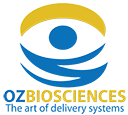
Reporter genes are commonly used in cell biology research.
OZ Biosciences offers reporter mRNAs that can be used as controls to study transfection and expression in mammalian cells using a variety of assays. They mimic fully processed mature mRNA.
These mRNAs are produced by in vitro transcription and stabilized at the 5" end by modified nucleotides capping (Cap1). They contain a poly(A) tail at the 3" end and are optimized to yield improved stability and performance.
They are modified with 5-methoxyuridine (5moU replaces U) to reduce innate immune responses.
We also offer unmodified mRNAs -- #MRNA9 (Tomato), #MRNA15 (GFP), #MRNA16 (F-Luc).
We recommend using our transfection reagents RmesFect or RmesFect Stem in order to reach high transfection efficiency and optimum protein expression level.
mRNA transfection provides several advantages :
- No need of nuclear uptake - protein expression directly in cytoplasm
- Faster protein expression than DNA transfection
- No genomic integration
- Protein expression directly related to mRNA quantity
- Perfect for transfecting slowing or non-dividing cells
- Protein expression in a total promoter-independent manner
- Transient transfection: mRNA based expression of proteins sustains for a limited time
![]()
- GFP mRNA has been designed to produce high expression level of Green Fluorescent Protein. It is a commonly used direct detection reporter in mammalian cell culture, yielding bright green fluorescence with an emission peak at 509 nm.
- F-Luc mRNA has been designed to produce high expression level of FireFly Luciferase protein. It is commonly used in mammalian cell culture to measure both gene expression and cell viability. It emits bioluminescence in the presence of the substrate, luciferin.
- Tomato mRNA has been designed to produce high expression level of Orange Fluorescent Protein. The detection can be done by fluorescent or confocal microscopy. The produced Tomato has an excitation maximum at 551-557 nm and emission maximum at 579-583 nm. Tomato expression level can also be monitored by fluorescence-activated cell sorter analysis (FACS).
- mCherry mRNA encodes the fluorescent protein, mCherry, which is derived from DsRed, a protein found in Discosoma sp. mCherry is a monomeric fluorophore with a peak absorption at 587 nm and emission at 610 nm. It is photostable and resistant to photobleaching.
- β-galactosidase (β-gal) mRNA, codes for a protein product of the bacterial LacZ gene. β-gal catalyzes the conversion of β-galactosides into monosaccharides. it is a common marker gene used to assess transfection efficiency.
Size: 20 µg, 100µg and 1mg.
For bulk, please contact us: order@ozbiosciences.com
Storage: -80°C
mRNAs ARE SHIPPED ON DRY ICE
Dry ice fee included in shipping cost
Please log in or register to see the prices for your country
The following items are 5 moU modified mRNAs -- if you need unmodified mRNAs, please visit this page.
ebiomall.com






>
>
>
>
>
>
>
>
>
>
>
最好能说得具体点,小弟对此几乎一窍不通
谢谢
1. 粗纯:将制备抗体的血清或是腹水,细胞上清,直接用盐析法进行处理,这样可以将这些物质里面的其他杂质去掉,获得蛋白的成分,但是由于是粗纯,里面会混有大量的其他蛋白,这样获得的抗体,纯度较低,用于实验中背景比较高。
2.通用型纯化:用抗体结合蛋白Protein A,Protein G或者Protein L。因为不同来源的抗体和这些抗体结合蛋白的结合能力不同,所以需要根据抗体来源选择使用哪种抗体将诶和蛋白最好。对于有一些单链抗体,则多半使用protein L来进行纯化。经过抗体结合蛋白的亲和纯化后,溶液中基本只保留了抗体的成分,其他蛋白都去掉了,抗体纯度可以比较高。相对来说,这种方法是大规模抗体制备中,用得最多的纯化方法,很多抗体公司都采用这种方法来对抗体进行纯化。
3.特异型纯化:但是有些抗体,需要纯度特别高,特异性特别好,就不能简单采用上述两种方法进行纯化了。必须要通过将抗原固定制备成特异的亲和纯化柱,再纯化抗体。这个时候得到的就全是针对一种抗原的抗体了,特异性最好。当然,由于牵涉到抗原固定等操作,成本相应是最高的。
1. 粗纯:将制备抗体的血清或是腹水,细胞上清,直接用盐析法进行处理,这样可以将这些物质里面的其他杂质去掉,获得蛋白的成分,但是由于是粗纯,里面会混有大量的其他蛋白,这样获得的抗体,纯度较低,用于实验中背景比较高。
2.通用型纯化:用抗体结合蛋白Protein A,Protein G或者Protein L。因为不同来源的抗体和这些抗体结合蛋白的结合能力不同,所以需要根据抗体来源选择使用哪种抗体将诶和蛋白最好。对于有一些单链抗体,则多半使用protein L来进行纯化。经过抗体结合蛋白的亲和纯化后,溶液中基本只保留了抗体的成分,其他蛋白都去掉了,抗体纯度可以比较高。相对来说,这种方法是大规模抗体制备中,用得最多的纯化方法,很多抗体公司都采用这种方法来对抗体进行纯化。
3.特异型纯化:但是有些抗体,需要纯度特别高,特异性特别好,就不能简单采用上述两种方法进行纯化了。必须要通过将抗原固定制备成特异的亲和纯化柱,再纯化抗体。这个时候得到的就全是针对一种抗原的抗体了,特异性最好。当然,由于牵涉到抗原固定等操作,成本相应是最高的。









